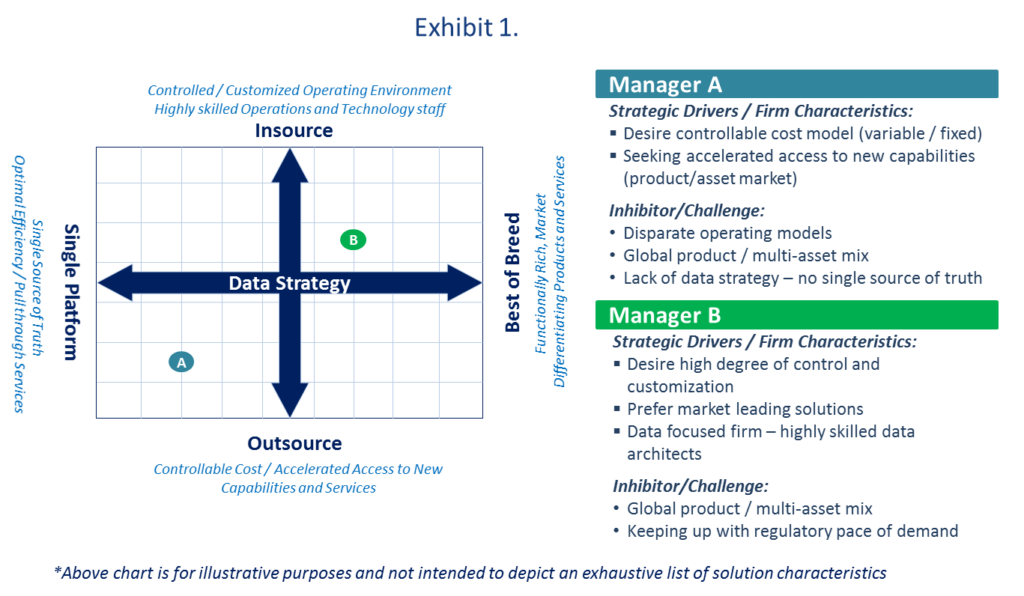With the growing desire to simplify operating models and reduce technology footprints, asset managers are assessing multiple paths of transformation to enable profitable growth. As was noted in Single Platform: Next Logical Evolution for Asset Managers?, recent developments and acquisitions have promoted advanced capabilities and introduced various new forms of front-to-back, ‘single platform’ solutions to the market. As a result of these advancements, rather than addressing a singular point of failure or concern (such as a new IBOR or OMS consolidation), firms are considering broader evaluations of their operating environments with the hope of achieving greater scale, nimbleness and data empowerment across their enterprise.
Getting Started
Given the optionality represented in the available solutions, it’s easy to understand how asset managers may be distracted by varying lists of advanced capabilities and struggle to assess which solution path offers the optimal fit. Logically, the buyer’s product, asset, security type, client, and global mix are fundamental to any assessment process. But other factors including attitudes towards outsourcing, pace of innovation, state of current technology, current data and analytics challenges, comfort with the cloud, and risk appetite are also essential to factor in.
Olmstead believes every transformation should be driven by specific business needs and evaluated based on a set of strategic decision criteria. Equally important to the decision criteria, is the establishment of weightings. Since it is unrealistic that a single platform will solve everything, a firm must determine how the acceptable compromises are weighted against the inherent benefits. This requires alignment on decision criteria from the top of the house, and serve as an invaluable guide for determining suitability throughout an assessment.
Though decision criteria will vary from firm to firm, the following are common priorities driving sourcing strategies:
- Accelerated access to new products or markets
- Access to timely, high-quality, enriched data to enable better decision making
- Data empowerment to support enhanced analytics
- Controllable and predictable economics
- Reduced implementation risk
Once the strategic decision criteria have been established, it’s important to consider the types of transformation available. As addressed previously, there is extended optionality available in the current market solutions (technology, outsourcing, data strategies, and hybrid models including a mix of various solutions) to support the needs of single platform. Before evaluating the various solution options, we believe it is critical to understand where you sit on the solution spectrum (see Exhibit 1), which is driven by the unique makeup and strategic drivers of your firm.

Due Diligence
After a path to transformation has been set, it’s important to execute a disciplined due diligence effort to validate a platform’s capabilities and service model; understand cost and effort to implement; and ensure alignment with the firm’s strategic vision for scale and growth. Shortcutting this assessment will result in cost overruns, time to market delays, and in a worst-case scenario – a partnership that inevitably will need to be unwound.
The following are key guidelines for due diligence assessments:
- Data should be at the forefront of your review both from a consumption and integration perspective. Regardless of the solution, issues with current data models will only be exacerbated by complex transformations unless addressed with a data centric approach. Best practices for due diligence should include an assessment of your firm’s data model.
- Distinguish between capabilities outlined within a strategic roadmap vs. those available in production today. Though both are equally important, the latter should be the focus of validation – and should be confirmed through proof of concept exercises as well as via production client references.
- Staff your assessment with key stakeholders and business users. The intent of migrating to these solutions should be enhancing current capabilities and providing users with improved timing, quality, and enriched data. Ensure that the review is conducted and validated through the eyes of the consumer.
- Include an assessment of peripheral services as applicable. Depending on the platform, component services may be available that can strengthen and enhance the overall end-to-end solution but should also be vetted for value and suitability. This may include EDM, data sourcing, custody, lending/liquidity transparency, etc.
Regardless of your path, a thoughtful and disciplined approach will reap rewards and ensure that your transformation effort aligns to the strategic drivers of your firm. Olmstead welcomes the opportunity to start a discussion on how we can help navigate your path to transformation.
